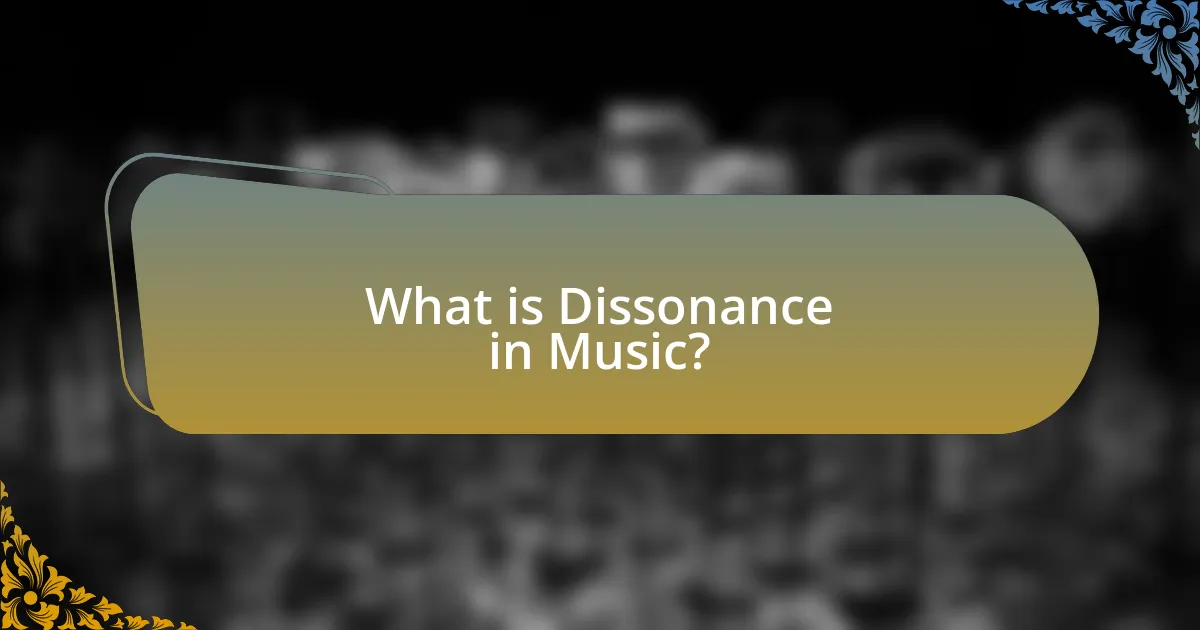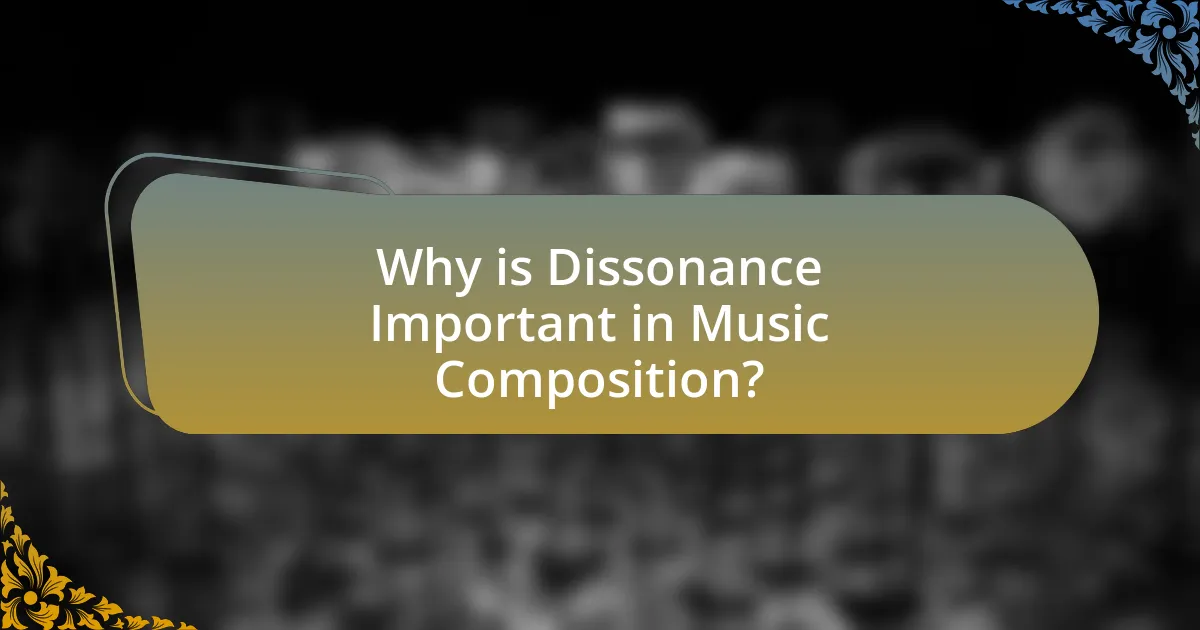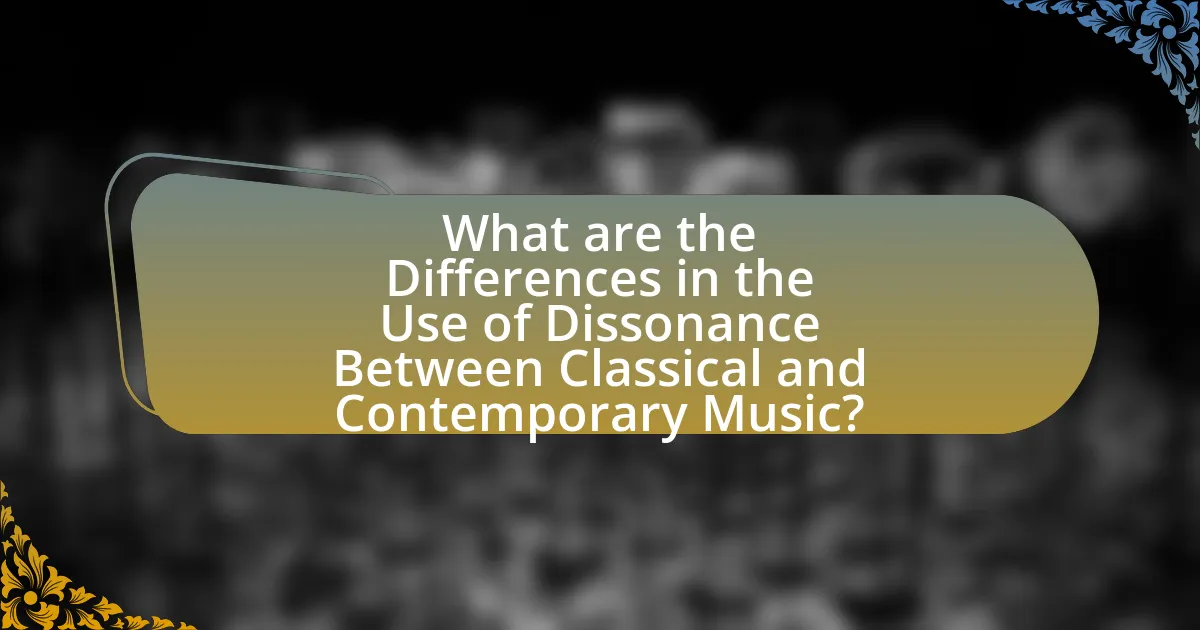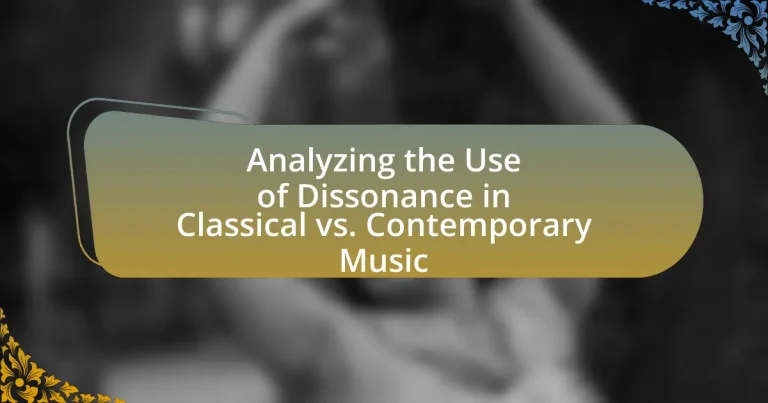The article analyzes the use of dissonance in both classical and contemporary music, defining dissonance as a combination of tones that creates tension and instability. It explores how classical composers like Beethoven and Wagner employed dissonance to build suspense and evoke emotional depth, often resolving it into consonance. In contrast, contemporary composers such as Steve Reich and Arnold Schoenberg embrace dissonance as a fundamental element of their musical language, using it to challenge traditional harmonic structures and express complex emotions. The article also discusses the historical evolution of dissonance, its role in emotional expression, and the differing techniques used by composers across genres.

What is Dissonance in Music?
Dissonance in music refers to a combination of tones that creates a sense of tension or instability, often perceived as harsh or unresolved. This phenomenon occurs when the frequencies of the notes played together do not align harmonically, leading to a feeling of discord. Historically, dissonance has been used intentionally by composers to evoke emotional responses, with examples found in both classical and contemporary music. For instance, in classical compositions, dissonance often resolves into consonance, creating a satisfying release of tension, while contemporary music may utilize dissonance more freely to challenge traditional harmonic structures.
How is dissonance defined in classical music?
Dissonance in classical music is defined as a combination of tones that creates a sense of tension or instability, often perceived as harsh or unresolved. This tension arises from intervals that do not conform to the traditional consonant harmonies, such as major and minor thirds, which are generally considered stable. Historical context shows that composers like Igor Stravinsky and Arnold Schoenberg utilized dissonance to evoke emotional depth and complexity, challenging the listener’s expectations and enhancing the expressive quality of their works.
What are the historical contexts of dissonance in classical compositions?
The historical contexts of dissonance in classical compositions include its evolution from the Renaissance through the Baroque, Classical, and Romantic periods, where it served various expressive and structural purposes. In the Renaissance, dissonance was often used to create tension and resolve within polyphonic textures, as seen in the works of composers like Josquin des Prez. The Baroque period, exemplified by Johann Sebastian Bach, utilized dissonance to enhance emotional depth and drive harmonic progressions. During the Classical era, composers such as Haydn and Mozart employed dissonance to create contrast and drama, often resolving it to consonance for structural clarity. In the Romantic period, figures like Wagner and Mahler expanded the use of dissonance to convey complex emotions and explore new harmonic languages, reflecting the era’s emphasis on individual expression. This historical trajectory illustrates how dissonance has been integral to the development of Western classical music, shaping its emotional and structural landscape.
How do composers utilize dissonance to create tension in classical music?
Composers utilize dissonance to create tension in classical music by deliberately incorporating intervals and chords that clash, generating a sense of instability. This tension is often resolved through subsequent consonant harmonies, creating emotional dynamics within the music. For example, composers like Beethoven and Wagner employed dissonance to heighten dramatic moments, using it to evoke feelings of conflict or anticipation. The use of dissonance is a fundamental technique in classical music, as evidenced by the prevalence of diminished and augmented chords, which are designed to create unease before resolution.
How is dissonance defined in contemporary music?
Dissonance in contemporary music is defined as the combination of tones that creates a sense of tension or instability, often contrasting with consonance, which provides resolution. This tension is utilized by composers to evoke emotional responses and challenge traditional harmonic structures. For instance, contemporary works frequently employ dissonant intervals, such as minor seconds or tritones, to create a sense of unease or complexity, reflecting the diverse influences and experimental approaches in modern composition. The use of dissonance has evolved, with composers like Arnold Schoenberg and Igor Stravinsky pushing boundaries, demonstrating that dissonance can be a fundamental element in conveying meaning and innovation in contemporary music.
What are the key characteristics of dissonance in contemporary compositions?
The key characteristics of dissonance in contemporary compositions include increased use of non-traditional harmonies, complex rhythmic structures, and a focus on texture and timbre. Contemporary composers often employ dissonance to create tension and emotional depth, moving away from the tonal resolutions typical in classical music. For example, composers like Steve Reich and John Adams utilize dissonance to enhance the narrative quality of their works, often incorporating elements of minimalism and polytonality. This shift reflects a broader trend in contemporary music where dissonance serves not only as a harmonic device but also as a means of expression, challenging listeners’ expectations and expanding the emotional palette of musical storytelling.
How do modern composers approach dissonance differently than classical composers?
Modern composers approach dissonance by embracing it as a fundamental element of their musical language, contrasting with classical composers who often viewed dissonance as a tension to be resolved. While classical composers like Bach and Beethoven typically used dissonance to create tension that would resolve into consonance, modern composers such as Arnold Schoenberg and Igor Stravinsky frequently employed dissonance to convey emotion and complexity without the necessity of resolution. This shift is evident in the use of atonality and polytonality in modern compositions, where dissonance is not merely a step towards resolution but an integral part of the musical texture. The evolution reflects a broader acceptance of dissonance in the 20th century, as composers sought to expand the emotional and expressive range of their music.

Why is Dissonance Important in Music Composition?
Dissonance is important in music composition because it creates tension and emotional depth, which are essential for engaging listeners. In both classical and contemporary music, dissonance serves as a tool for composers to evoke feelings, build suspense, and enhance resolution when followed by consonance. Historical examples include the use of dissonance in Beethoven’s late string quartets, where it heightens emotional expression, and in contemporary works by composers like Steve Reich, who utilize dissonance to create complex textures and rhythmic interplay. This strategic use of dissonance not only enriches the musical narrative but also reflects the evolving aesthetic values in music across different eras.
What role does dissonance play in emotional expression in music?
Dissonance plays a crucial role in emotional expression in music by creating tension and evoking feelings of unease or conflict. This tension can enhance the emotional depth of a piece, allowing composers to convey complex feelings such as sadness, anxiety, or longing. For instance, in classical music, composers like Beethoven and Wagner utilized dissonance to heighten emotional impact, as seen in Beethoven’s late string quartets, where dissonant chords create a sense of struggle and resolution. In contemporary music, artists often employ dissonance to challenge listeners’ expectations, further enriching the emotional landscape of their work. Research indicates that dissonance can activate specific emotional responses in listeners, demonstrating its effectiveness as a tool for emotional expression in various musical genres.
How does dissonance contribute to the overall mood of a piece?
Dissonance contributes to the overall mood of a piece by creating tension and emotional complexity. In both classical and contemporary music, dissonant chords or intervals evoke feelings of unease or anticipation, which can enhance the listener’s emotional experience. For example, in classical compositions like Beethoven’s “Symphony No. 7,” dissonance is used strategically to build intensity and drive the narrative forward. Similarly, contemporary works often utilize dissonance to reflect modern themes of conflict and uncertainty, as seen in the music of composers like Steve Reich. This intentional use of dissonance shapes the mood by contrasting with consonance, thereby heightening emotional responses and engaging the audience more deeply.
What are examples of emotional responses elicited by dissonance?
Emotional responses elicited by dissonance include feelings of tension, anxiety, and unease. These responses occur because dissonance disrupts harmonic expectations, leading listeners to experience discomfort or a sense of conflict. Research in music psychology indicates that dissonance can evoke heightened emotional states, such as fear or sadness, particularly in contemporary music where dissonant chords are used to create dramatic effects. For instance, studies show that dissonant intervals can trigger physiological responses, such as increased heart rate, reflecting the emotional intensity associated with dissonance.
How does dissonance influence musical structure and development?
Dissonance significantly influences musical structure and development by creating tension that propels harmonic progression and emotional expression. In classical music, composers like Beethoven and Wagner utilized dissonance to build suspense and resolve it through consonance, shaping the overall narrative of their compositions. For instance, Wagner’s use of chromaticism and unresolved chords in “Tristan und Isolde” exemplifies how dissonance can drive the music forward, leading to dramatic climaxes and resolutions. In contemporary music, dissonance continues to play a crucial role, as seen in the works of composers like Steve Reich and John Adams, who employ dissonant harmonies to evoke complex emotional landscapes and challenge traditional tonal structures. This ongoing use of dissonance across genres illustrates its fundamental role in shaping musical development and enhancing expressive depth.
What are the techniques used to resolve dissonance in compositions?
Techniques used to resolve dissonance in compositions include consonant harmonization, voice leading, and modulation. Consonant harmonization involves moving from dissonant chords to stable, consonant chords, creating a sense of resolution. Voice leading focuses on the smooth transition of individual musical lines, ensuring that dissonant notes resolve to consonant ones through stepwise motion. Modulation shifts the tonal center, allowing dissonance to be resolved in a new key, which can provide fresh perspectives on harmonic tension. These techniques are foundational in both classical and contemporary music, as they guide listeners through emotional and structural journeys within compositions.
How does dissonance affect the listener’s experience of a piece?
Dissonance significantly impacts the listener’s experience by creating tension and emotional complexity within a musical piece. This tension often evokes a range of feelings, from discomfort to intrigue, compelling listeners to engage more deeply with the music. Research indicates that dissonant intervals can stimulate heightened emotional responses, as evidenced by studies showing that listeners often report stronger feelings of anxiety or excitement when exposed to dissonant harmonies compared to consonant ones. For instance, a study published in the journal “Psychology of Music” by researchers at the University of California found that participants rated dissonant music as more emotionally charged, demonstrating that dissonance plays a crucial role in shaping the overall emotional landscape of a composition.

What are the Differences in the Use of Dissonance Between Classical and Contemporary Music?
The primary difference in the use of dissonance between classical and contemporary music lies in the context and function of dissonance within each genre. In classical music, dissonance often serves as a tension-building device that resolves into consonance, adhering to established harmonic rules, as seen in the works of composers like Beethoven and Mozart. In contrast, contemporary music frequently embraces dissonance as a fundamental element, using it to create atmosphere, express emotion, or challenge traditional harmonic structures, as exemplified by composers such as Arnold Schoenberg and John Cage. This shift reflects a broader evolution in musical language, where dissonance is no longer merely a means to an end but a vital component of the compositional palette.
How do the purposes of dissonance differ in classical versus contemporary music?
The purposes of dissonance in classical music primarily revolve around tension and resolution, while in contemporary music, dissonance often serves to create emotional depth and challenge traditional harmonic structures. In classical compositions, dissonance is typically used to build suspense, leading to a resolution that provides a sense of closure, as seen in the works of composers like Beethoven and Mozart. In contrast, contemporary music, exemplified by artists such as John Cage and Steve Reich, frequently embraces dissonance as a means of expression, allowing for ambiguity and complexity without necessarily resolving to consonance, thus reflecting modern themes and emotional landscapes. This shift highlights the evolving role of dissonance from a tool for structural integrity in classical music to a vehicle for exploration and innovation in contemporary music.
What are the contrasting techniques used in classical and contemporary dissonance?
Classical dissonance primarily employs techniques such as functional harmony and voice leading, while contemporary dissonance often utilizes atonality and extended techniques. In classical music, dissonance is typically resolved to consonance, following established harmonic progressions, as seen in the works of composers like Beethoven and Mozart. In contrast, contemporary composers like Arnold Schoenberg and John Cage embrace dissonance as a central element, often disregarding traditional resolutions and exploring new sound textures. This shift reflects a broader evolution in musical language, where dissonance serves not just as a tension to be resolved but as a fundamental aspect of the compositional palette.
How do cultural influences shape the use of dissonance in both genres?
Cultural influences shape the use of dissonance in both classical and contemporary music by dictating the emotional and aesthetic values associated with dissonance. In classical music, cultural contexts often emphasize harmony and resolution, leading composers to use dissonance as a tension-building device that ultimately resolves to consonance, reflecting societal norms of order and balance. For example, the use of dissonance in the works of composers like Beethoven often mirrors the Romantic ideals of struggle and resolution, which were prevalent in 19th-century European culture.
In contrast, contemporary music often embraces dissonance as a means of expression and identity, reflecting diverse cultural backgrounds and modern societal complexities. Genres such as jazz and avant-garde music utilize dissonance to challenge traditional norms and explore new sonic landscapes, showcasing influences from various cultural movements and social issues. For instance, the use of dissonance in jazz can be traced back to African American musical traditions, which prioritize improvisation and emotional expression, thus reshaping the listener’s experience.
Overall, cultural influences dictate how dissonance is perceived and utilized, with classical music often adhering to traditional values of resolution, while contemporary music embraces dissonance as a form of artistic freedom and cultural commentary.
What are the notable examples of dissonance in classical music?
Notable examples of dissonance in classical music include Igor Stravinsky’s “The Rite of Spring,” which features complex polytonality and harsh intervals that evoke primal emotions. Another significant example is Arnold Schoenberg’s “Pierrot Lunaire,” where the use of atonality and dissonant harmonies challenges traditional tonal structures. Additionally, Béla Bartók’s “Music for Strings, Percussion, and Celesta” employs dissonance to create tension and contrast within its rhythmic and melodic framework. These works exemplify how dissonance serves as a crucial element in conveying emotional depth and complexity in classical compositions.
Which composers are known for their innovative use of dissonance in classical music?
Composers known for their innovative use of dissonance in classical music include Igor Stravinsky, Arnold Schoenberg, and Claude Debussy. Stravinsky’s “The Rite of Spring” features complex rhythmic structures and dissonant harmonies that challenged traditional tonality. Schoenberg pioneered atonality and the twelve-tone technique, fundamentally altering the approach to dissonance in music. Debussy’s impressionistic style often employed non-traditional scales and unresolved chords, creating a unique sound palette that embraced dissonance. These composers significantly influenced the evolution of musical language in the 20th century.
What specific pieces exemplify the effective use of dissonance in classical music?
Specific pieces that exemplify the effective use of dissonance in classical music include Igor Stravinsky’s “The Rite of Spring,” Arnold Schoenberg’s “Pierrot Lunaire,” and Béla Bartók’s “Music for Strings, Percussion, and Celesta.” In “The Rite of Spring,” Stravinsky employs dissonance to evoke primal emotions and create tension, particularly in the famous “Sacrificial Dance.” Schoenberg’s “Pierrot Lunaire” utilizes atonality and dissonance to express complex psychological states, showcasing the Sprechstimme technique. Bartók’s work features dissonant harmonies that reflect folk influences and create a unique sound world. These pieces are recognized for their innovative use of dissonance, which challenges traditional harmonic structures and enhances emotional depth.
What are the notable examples of dissonance in contemporary music?
Notable examples of dissonance in contemporary music include works by composers such as Steve Reich, John Adams, and György Ligeti. Steve Reich’s “Different Trains” employs dissonant harmonies to evoke emotional contrasts, while John Adams’ “Shaker Loops” utilizes dissonance to create tension and release. György Ligeti’s “Atmosphères” features clusters of dissonant tones that contribute to its unique soundscape. These examples illustrate how contemporary composers effectively use dissonance to enhance emotional depth and complexity in their music.
Which contemporary composers have pushed the boundaries of dissonance?
Contemporary composers who have pushed the boundaries of dissonance include Steve Reich, Arnold Schoenberg, and György Ligeti. Steve Reich’s minimalist techniques often incorporate dissonant harmonies that challenge traditional tonal structures, while Arnold Schoenberg is known for developing the twelve-tone technique, which fundamentally altered the approach to dissonance in music. György Ligeti’s works, such as “Atmosphères,” utilize complex textures and microtonal intervals, further expanding the concept of dissonance in contemporary composition. These composers exemplify the evolution of dissonance beyond classical norms, demonstrating its integral role in modern music.
What specific pieces exemplify the effective use of dissonance in contemporary music?
Specific pieces that exemplify the effective use of dissonance in contemporary music include “Threnody to the Victims of Hiroshima” by Krzysztof Penderecki, “Black Angels” by George Crumb, and “Different Trains” by Steve Reich. These compositions utilize dissonance to evoke emotional responses and convey complex themes. For instance, Penderecki’s work employs clusters of sound to create a sense of chaos and urgency, reflecting the horrors of war. Crumb’s “Black Angels” incorporates extended techniques and dissonant harmonies to enhance its haunting atmosphere, while Reich’s “Different Trains” juxtaposes dissonant string textures with recorded speech to explore themes of memory and trauma. Each piece demonstrates how dissonance can be a powerful tool in contemporary music to communicate profound ideas and emotions.
How can musicians effectively incorporate dissonance into their compositions?
Musicians can effectively incorporate dissonance into their compositions by using it to create tension and emotional depth. This can be achieved through techniques such as employing non-chord tones, utilizing altered chords, and exploring unconventional harmonic progressions. For instance, composers like Igor Stravinsky and Arnold Schoenberg have demonstrated the power of dissonance in their works, where dissonant intervals serve to heighten drama and contrast. Historical examples show that dissonance has been a crucial element in various musical movements, allowing composers to evoke specific feelings and enhance the narrative of their pieces.


